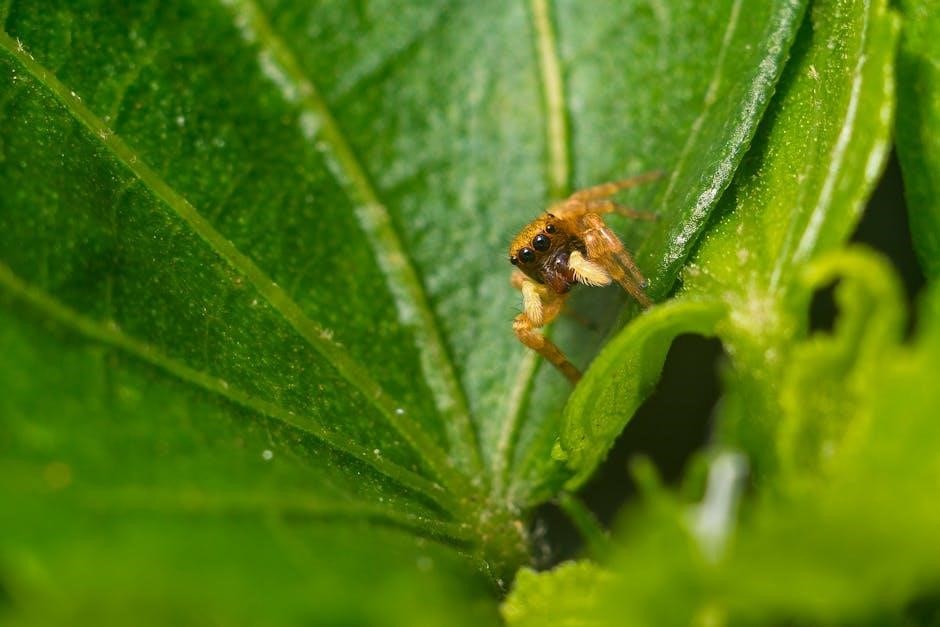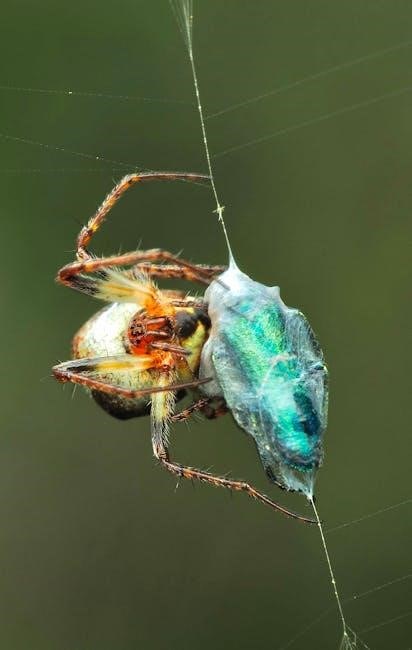
This guide provides essential information on feeding jumping spiders, covering everything from suitable prey to dietary variety. Understanding their nutritional needs is crucial for maintaining their health and activity levels. By providing the correct food and schedule, you can ensure a thriving jumping spider.
Jumping spiders, known for their remarkable agility and hunting skills, have diets that primarily consist of small arthropods. As generalist predators, they actively hunt a wide variety of prey. Understanding their dietary needs is crucial for their health and well-being in captivity. Providing a balanced and varied diet is key to ensuring they thrive.
Insects form the cornerstone of their diet, with flies, crickets, and small moths being ideal choices. These agile hunters readily feed on feeder insects. It’s essential to offer food items that are appropriately sized relative to the spider’s own size. Baby spiderlings require smaller prey, such as fruit flies, while adults can handle larger insects.
Jumping spiders also enjoy nectar from fruits, like watermelon and mangoes. Sugars can give them a sweet treat. A mix of prey types helps maintain a balanced diet. Offering a variety of insects ensures they receive the necessary nutrients for optimal health and activity levels.
Suitable Live Prey for Jumping Spiders
Selecting appropriate live prey is vital for the health and well-being of your jumping spider. A variety of insects can serve as food, ensuring a balanced diet. Crickets, flies, roaches, mealworms, waxworms, and moths are all suitable options. It’s crucial to choose prey that is not larger than 1.5 times the spider’s size to prevent injury or stress during hunting.

Flies, particularly blue and green bottle flies, are popular choices due to their ease of keeping and the spiders’ eagerness to hunt them. Crickets are another readily accepted food source, offering essential nutrients. Mealworms and waxworms can be offered in moderation as they are higher in fat content.
Other options include small dubia roaches, which are nutritious and easy to breed. Moths can also be offered, providing variety and stimulating the spider’s natural hunting instincts. Always ensure that the prey is healthy and free from pesticides or diseases to safeguard your spider’s health.
Crickets as a Food Source
Crickets are a widely used and nutritious food source for jumping spiders. They offer a good balance of protein and other essential nutrients, making them a staple in many jumping spider diets. Crickets are relatively easy to obtain from pet stores or online suppliers, and they are generally well-accepted by jumping spiders of various sizes and ages.
When feeding crickets, it’s important to select appropriately sized insects. The cricket should be no larger than 1.5 times the size of the spider to prevent any risk of injury during the hunt. Gut-loading crickets before feeding them to your spider is also beneficial. This involves feeding the crickets nutritious food, such as vegetable peelings or commercial cricket food, which then passes those nutrients on to your spider.
Ensure the crickets are healthy and active. A healthy cricket will be more appealing to your spider and provide better nutritional value. Avoid using crickets that appear sluggish, sick, or have been exposed to pesticides.
Flies as a Food Source
Flies are a highly popular and convenient food option for jumping spiders, particularly favored for their manageable size and ease of keeping. Blue bottle and green bottle flies are common choices, readily accepted by most jumping spider species, even smaller spiderlings.
Culturing flies can be relatively simple, providing a continuous and cost-effective food source. Fruit flies, especially wingless varieties, are excellent for spiderlings, while larger flies suit sub-adults and adults. The active movement of flies also stimulates the jumping spider’s natural hunting instincts, offering enrichment;
When introducing flies, ensure the enclosure provides adequate space for the spider to hunt effectively. Avoid overcrowding the enclosure with too many flies at once, as this may stress the spider. Regularly remove any uneaten flies to maintain a clean and hygienic environment.
Flies offer a nutritious and engaging food source, contributing to the overall health and well-being of your jumping spider. Their ease of availability and suitability for different life stages make them an invaluable part of a balanced diet.
Mealworms and Waxworms as Food
Mealworms and waxworms can serve as occasional treats for jumping spiders, offering a higher fat content than other feeder insects. These worms are readily available and easy to keep, making them a convenient option for supplementing the spider’s diet.
However, it’s crucial to offer mealworms and waxworms sparingly, as their high fat content can lead to obesity and other health issues if fed too frequently. They should not be the primary food source, but rather a supplemental addition to a more varied diet.
When feeding mealworms, consider crushing their heads to prevent them from burrowing into the substrate and potentially harming the spider during molting. Waxworms, being softer, pose less of a risk but should still be offered in moderation.
Ensure the size of the mealworms or waxworms is appropriate for the spider’s size to avoid any difficulties in consumption. Observe the spider’s feeding behavior to ensure they are able to handle the prey effectively.
While mealworms and waxworms offer nutritional value, a balanced diet consisting primarily of insects like crickets and flies remains essential for the overall health and well-being of your jumping spider.
Other Feeder Insects (Roaches, Moths, Dubias)
Beyond the commonly used crickets and flies, several other insects can provide valuable nutrition for jumping spiders. Roaches, particularly smaller species, offer a protein-rich meal and can be a good alternative food source. Dubia roaches are a popular choice due to their ease of care and nutritional content.

Moths, especially those caught indoors, can also serve as an occasional treat. However, ensure that the moths haven’t been exposed to pesticides or other harmful substances. Wild-caught insects should always be approached with caution.
When introducing roaches or dubias, select sizes appropriate for the spider to handle easily; Monitor the spider’s feeding response to ensure successful capture and consumption. Some spiders may readily accept these alternative feeders, while others may prefer more familiar prey.
Offering a variety of feeder insects helps to provide a more balanced diet and can stimulate the spider’s natural hunting instincts. Introducing new prey types can prevent dietary boredom and ensure the spider receives a wider range of nutrients.
Always prioritize the health and safety of the feeder insects. Ensure they are properly gut-loaded with nutritious foods before offering them to your jumping spider to maximize their nutritional value.
Feeding Frequency for Spiderlings, Sub-Adults, and Adults
The feeding frequency for jumping spiders varies significantly depending on their life stage. Spiderlings, being in a rapid growth phase, require more frequent meals than adults. A good rule of thumb is to feed spiderlings every day or every other day with appropriately sized prey, such as fruit flies.
Sub-adults, nearing their final molt, should be fed every 3 to 7 days. Monitor their abdomen size to gauge their hunger levels. A plump abdomen indicates sufficient feeding, while a shrunken abdomen suggests the need for more frequent meals.
Adult jumping spiders can be fed every 5 to 10 days. Their metabolic rate slows down as they reach maturity, reducing their food requirements. Overfeeding can lead to obesity and health problems, so it’s important to adjust the feeding schedule accordingly.
Before a molt, jumping spiders may refuse food. This is normal behavior, and you should remove any uneaten prey from their enclosure. After molting, wait a day or two before offering food again to allow their fangs to harden.
Always observe your spider’s behavior and adjust the feeding schedule based on individual needs. Some spiders may have higher or lower metabolisms than others.
Size of Prey Relative to Spider Size
The size of the prey offered to a jumping spider is a critical factor in ensuring successful feeding and preventing injury to the spider. A general guideline is that the prey should not be larger than 1.5 times the spider’s body size. Offering prey that is too large can overwhelm the spider and potentially lead to a failed hunt or even injury.
For spiderlings, this means starting with very small prey, such as fruit flies or pinhead crickets. As the spiderling grows, gradually increase the size of the prey accordingly. Monitor the spider’s ability to successfully capture and consume the prey.
Sub-adult and adult jumping spiders can handle larger prey, but it’s still important to avoid offering insects that are excessively large or difficult to manage. Crickets, small roaches, and appropriately sized flies are good options.
Always observe the spider’s behavior when introducing new prey. If the spider appears hesitant or struggles to capture the prey, it may be too large. Remove the prey and offer a smaller alternative.
Providing appropriately sized prey ensures that the spider can successfully hunt and consume its meal without risk of injury, contributing to its overall health and well-being.
Nutritional Needs and Dietary Variety
Jumping spiders, like all living creatures, require a balanced diet to thrive. While they primarily feed on insects, providing a variety of prey items is essential to meet their nutritional needs. Different insects offer different levels of protein, fats, and micronutrients, contributing to the spider’s overall health and vitality.
A diet consisting solely of one type of insect can lead to nutritional deficiencies over time. For example, crickets are a good source of protein, but they may lack certain vitamins and minerals. Supplementing their diet with flies, mealworms, or other feeder insects helps ensure they receive a wider range of nutrients.
Varying the diet also stimulates the spider’s hunting instincts and prevents boredom. Introducing new and different prey items can keep them engaged and active.
Consider offering a mix of crickets, flies, roaches, mealworms, and waxworms to provide a well-rounded diet. Gut-loading feeder insects with nutritious foods before offering them to the spider can further enhance their nutritional value.
Monitor the spider’s health and activity levels to assess the effectiveness of the diet. A healthy jumping spider will be active, alert, and have a vibrant appearance.
Supplementing Diet with Nectar and Fruits
While jumping spiders primarily consume insects, offering nectar and fruits can provide supplementary nutrients and hydration. These items can serve as a sweet treat and a source of energy, enriching their overall diet. Though not a primary food source, small amounts of fruits and nectar can offer additional benefits.
Jumping spiders are known to enjoy sucking the nectar from various fruits. Watermelon, strawberries, grapes, and mangoes are suitable options. Offer small, manageable pieces of fruit to prevent them from becoming overwhelmed or creating a mess in their enclosure.
Nectar can be provided by diluting honey with water. Place a small drop of this solution on a cotton swab or a shallow dish. Ensure the container is easily accessible to the spider without posing a drowning risk.
Observe the spider’s behavior to determine if they are interested in consuming the fruit or nectar. Not all jumping spiders will readily accept these supplements, so it’s important to monitor their preferences.
Supplementing with fruits and nectar can provide extra sugar. Always ensure that the primary diet consists of appropriately sized insects to meet their protein requirements.